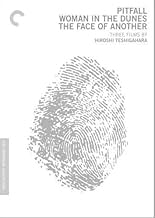VALUTAZIONE IMDb
7,5/10
4463
LA TUA VALUTAZIONE
Aggiungi una trama nella tua linguaA man wanders into a seemingly deserted town with his young son in search of work. But after a bit of bad luck, he joins the town's population of lost souls.A man wanders into a seemingly deserted town with his young son in search of work. But after a bit of bad luck, he joins the town's population of lost souls.A man wanders into a seemingly deserted town with his young son in search of work. But after a bit of bad luck, he joins the town's population of lost souls.
- Premi
- 1 candidatura in totale
Recensioni in evidenza
This film is very difficult to find in the West. It's not on video and you'd probably have to be lucky and find it at a film festival or a revival house. It's the first collaboration between director Teshigahara, writer Kodo Abe, and composer Toru Takemitsu, who went on to make the more widely available WOMAN IN THE DUNES and FACE OF ANOTHER. It's not quite as strong as WitD but is on par with FoA. This is a satire about a deserted town who's inhabitants are ghosts swallowed up by corruption. Teshigahara's direction is solid and Takemitsu comes up with another appropriately dissonant score balancing tension and humor. It's worth seeing for anyone interested in the three principal collaborators, particularly since opportunities to see it are rare. Takemitsu in particular could almost single handedly make a movie worth watching.
Most people watch this movie after 'Suna no Onna' (Woman In The Dunes). Well, if you compare these 2 movies, the result would be defeat for Pitfall.
What is that? Story builds up, builds up, builds up and... Abruptly ends. There are question marks left over everything. No this is not a movie you can understand with watching it second time like 'Memento'.
I give 5 stars out of respect to the dead/alive ghastly effects for 1960s.
What is that? Story builds up, builds up, builds up and... Abruptly ends. There are question marks left over everything. No this is not a movie you can understand with watching it second time like 'Memento'.
I give 5 stars out of respect to the dead/alive ghastly effects for 1960s.
Absolutely unique and bizarre movie in the best sense. It starts as an almost Kafakaesque eerie horror, then becomes a comic ghost story and then an almost Ken Loachian tale of labor struggle. Ultimately it's a cosmic black comedy. That's a lot of narrative tones for one film to cover, but this manages it all with grace and eloquence.
If you're familiar with Hiroshi Teshigahara's work, especially the notorious "Woman In The Dunes", you will understand the starkness, the harsh reality, the irony of this film. Ostensibly about a miner who is stalked by a man in a white suit and who then is killed for reasons that do not become apparent until nearly the end of the film, the film is, like "Dunes", an uncompromising look at life. The film is technically superb on the DVD box available, and it is highly recommended. This film is not for everyone, it is for people who are interested in serious Japanese cinema. There are nuances in this film that show the mark of a great director, though. Again, be prepared: This is not happy go lucky. It triumphs mostly because of its persistence of vision. That is an endorsement for any filmmaker.
As the ghosts of two of the victims of the man in the white suit chase his Vespa, they yell, "You can't kill someone for no reason." Whatever that reason is, it is never shared with us. It's sad enough that the characters in this movie are so lost, but that someone would care enough about them to seek them out and kill them. The man in the white suit has a book and after carrying out his hit, or setting one up, he quietly writes things in that book. Is he the grim reaper? Does he represent organized crime? Is he a solo player? He is magical in a Satanic sense. He comes between two warring labor unions, creating enough distrust to destroy what they fight for and them also. One of the strangest characters is a little boy, the son of the first victim, who seems only intent on eating throughout the movie. At one point, he catches a frog, smashes it on the rocks, and then pulls off its skin. He seems immune to emotion and we only know that he is a little eating machine. This is a film that you will think about for a long time if you can find it. It is unsatisfying on the one hand and highly provocative on the other.
Lo sapevi?
- QuizThis is the first of four film collaborations involving director Hiroshi Teshigahara, author Kôbô Abe, and scorer Tôru Takemitsu. Their other film collaborations were La donna di sabbia (1964), Il volto di un altro (1966) and Moetsukita chizu (1968).
- ConnessioniFeatured in Music for the Movies: Tôru Takemitsu (1994)
I più visti
Accedi per valutare e creare un elenco di titoli salvati per ottenere consigli personalizzati
- How long is Pitfall?Powered by Alexa
Dettagli
Botteghino
- Lordo in tutto il mondo
- 30.078 USD
- Tempo di esecuzione1 ora 37 minuti
- Colore
- Proporzioni
- 1.37 : 1
Contribuisci a questa pagina
Suggerisci una modifica o aggiungi i contenuti mancanti


![Trailer [OV]](https://m.media-amazon.com/images/M/MV5BM2RlZGYyMjAtOTFhNS00ZmZmLWJkYmEtYTg2ODM5ZTBhN2RlXkEyXkFqcGdeQXRyYW5zY29kZS13b3JrZmxvdw@@._V1_QL75_UX500_CR0)











